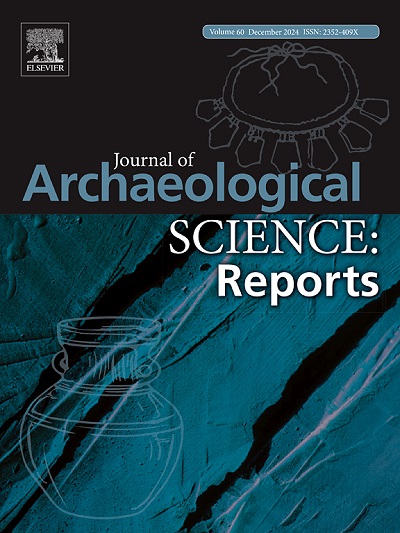A non-invasive archaeometric protocol for characterizing possible Corallium rubrum-related carbonate materials in decorations on Iron Age bronze fibulae of the Golasecca culture
IF 1.5
2区 历史学
0 ARCHAEOLOGY
引用次数: 0
Abstract
In the Iron Age, the Golasecca culture in Northwestern Italy connected Italic populations with transalpine and Celtic ones. From the 7th century BCE, in some jewellery artefacts (bronze fibulae and pendants) a whitish material constituting either part of the objects or nestled decorations is observed. Archaeologists identify it as coral (Corallium rubrum), its red hue whitened by the passing of time. However, few archaeometric studies have been carried out so far, also because of their invasiveness. 46 artefacts with whitish decorations from the archaeological sites of Como, Castelletto Ticino and Golasecca (stored in the Museo Civico Archeologico ‘P. Giovio’, in Como) are investigated here with a novel, non-destructive, multi-analytical protocol (i.e., μ-Raman spectroscopy, μ-X-ray diffraction, optical microscopy and SEM-EDS in low-vacuum), which completely safeguards their integrity. This approach, applied on the artefacts as such, allows identifying their constituent materials and degradation byproducts, extrapolating information about their nature, history and manufacturing process. Ca-carbonates – in the form of calcite – are identified in the decorations of most studied artefacts. This evidence alone does not account for their biologic origin (i.e., from C. rubrum), but other aspects can help in solving such an issue. In several artefacts, high-Mg calcite (HMC, a marker for biogenic carbonates) + polyenes (the typical pigments of red coral), sole HMC or even a mixture of HMC + LMC are identified – often coupled to typical coral micro-morphologies. A biogenic origin for these carbonates (i.e. red coral, though other similar species cannot be completely ruled out) can certainly be ascertained – lack of polyenes being justified by possible denaturation over time. In other artefacts, however, low-Mg-calcite (LMC) or even pure-calcite (i.e., with no detectable Mg) are found with no polyenes – hinting a possible inorganic origin. Most of these, however, show typical coral micro-morphologies. In these decorations, Mg-depletion might thus depend on the meteoric diagenesis of originally biogenic carbonates, responsible for transformation of HMC to LMC (or even pure-calcite) and decay of polyenes. Other materials are also seldom detected – i.e., gypsum, probably resulting from sulfation of an original coralline matrix interred in acidic soils, and Ca-phosphates, due to sporadic use of bones. All these evidences point to the fact that C. rubrum was feasibly used in at least ≈ 70 % of the studied decorated artefacts. For what concerns the composition of the alloy, bronze or lead-bronze can be found in different artefacts – or even different portions of the same item – possibly depending on sharp technological issues, dictated by fluidity or workability during manufacture.

用于确定戈拉塞卡文化铁器时代青铜纤维装饰中可能存在的与红珊瑚有关的碳酸盐材料特征的非侵入式考古规程
在铁器时代,意大利西北部的戈拉塞卡(Golasecca)文化将意大利人与跨高山和凯尔特人联系在一起。从公元前 7 世纪开始,在一些珠宝工艺品(青铜纤环和吊坠)中发现了一种白色物质,这种物质或是构成器物的一部分,或是嵌套在器物上的装饰。考古学家认定这是珊瑚(Corallium rubrum),其红色的色调随着时间的流逝而变白。然而,由于其侵入性,迄今为止很少进行考古计量研究。46 件来自科莫、Castelletto Ticino 和 Golasecca 考古遗址(保存在科莫的 P. Giovio 市考古博物馆)的带白色装饰的工艺品在这里进行了研究,采用了一种新颖的、非破坏性的、多重分析方案(即低真空下的μ-拉曼光谱、μ-X 射线衍射、光学显微镜和扫描电镜-电子显微镜),完全保证了它们的完整性。这种方法适用于文物本身,可以确定其组成材料和降解副产品,推断出有关其性质、历史和制造工艺的信息。在大多数研究文物的装饰中都发现了方解石形式的碳酸钙。仅凭这一证据并不能说明它们的生物起源(即来自 C. rubrum),但其他方面也有助于解决这一问题。在一些人工制品中,发现了高镁方解石(HMC,生物碳酸盐的标志)+ 多烯(红珊瑚的典型色素)、单一 HMC 或甚至 HMC + LMC 的混合物--通常与典型的珊瑚微形态相结合。这些碳酸盐(即红珊瑚,但也不能完全排除其他类似物种)的生物起源肯定是可以确定的--缺乏聚烯烃的原因可能是随着时间的推移发生了变性。不过,在其他人工制品中,发现了低镁方解石(LMC)甚至纯方解石(即检测不到镁),但没有多烯--这暗示了可能的无机来源。不过,其中大多数都显示出典型的珊瑚微观形态。因此,在这些装饰物中,镁的缺失可能取决于最初的生物碳酸盐的陨石成因,负责将 HMC 转化为 LMC(甚至纯方解石)和多烯的衰变。此外,还很少发现其他物质,如石膏(可能是埋藏在酸性土壤中的原始珊瑚基质硫化所致)和钙磷酸盐(由于零星使用骨骼)。所有这些证据都表明,在所研究的装饰文物中,至少有≈70%的文物使用了红珊瑚。就合金成分而言,青铜或铅青铜可能出现在不同的器物中,甚至出现在同一器物的不同部分,这可能取决于制造过程中的流动性或可加工性所决定的尖锐技术问题。
本文章由计算机程序翻译,如有差异,请以英文原文为准。
求助全文
约1分钟内获得全文
求助全文
来源期刊

Journal of Archaeological Science-Reports
ARCHAEOLOGY-
CiteScore
3.10
自引率
12.50%
发文量
405
期刊介绍:
Journal of Archaeological Science: Reports is aimed at archaeologists and scientists engaged with the application of scientific techniques and methodologies to all areas of archaeology. The journal focuses on the results of the application of scientific methods to archaeological problems and debates. It will provide a forum for reviews and scientific debate of issues in scientific archaeology and their impact in the wider subject. Journal of Archaeological Science: Reports will publish papers of excellent archaeological science, with regional or wider interest. This will include case studies, reviews and short papers where an established scientific technique sheds light on archaeological questions and debates.
 求助内容:
求助内容: 应助结果提醒方式:
应助结果提醒方式:


